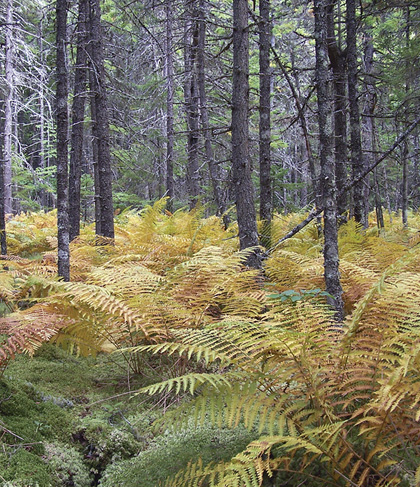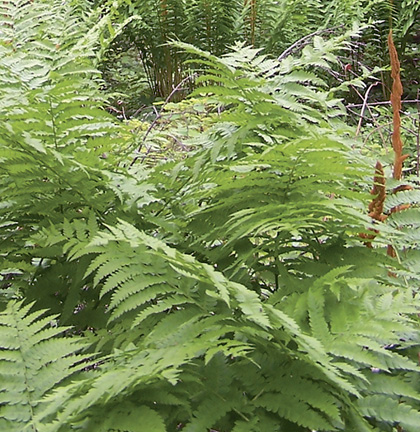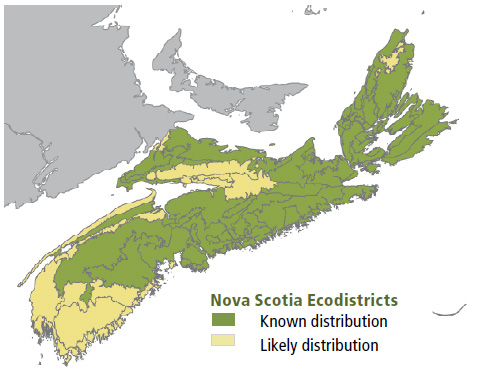
Forest Vegetation types - WC1
WC1 — Black spruce / Cinnamon fern / Sphagnum
Picea mariana / Osmunda cinnamomea /Sphagnum spp.
 |
| Tyndal Road, Cumberland County |
Concept: The Black spruce / Cinnamon fern / Sphagnum forest is characterized by black spruce canopy dominance, moderate to high herbaceous cover, and by a well-developed layer of sphagnum mosses. It is found on wet, nutrient poor soil, persisting as an edaphic climax. This Vegetation Type (VT) is similar to WC2 (Black spruce / Lambkill – Labrador tea / Sphagnum), which is an even more nutrient poor ecosystem found on sites with further reduced ground and surface water flow.
Vegetation: Crown closure is moderate to high, although some stands support more widely spaced trees. The canopy is heavily dominated by black spruce, or infrequently by hybrid black spruce-red spruce, with lesser balsam fir. Other trees are sparsely scattered with low cover. The understory supports low to moderate levels of woody species but higher herbaceous cover. Characteristic vascular plants include false holly, cinnamon fern, creeping snowberry, goldthread and three seeded sedge. Bryophyte development is high, composed of sphagnum moss and lesser amounts of common upland species. Ladies' tresses and/or pale fat-leaved sphagnum, with small pockets of common green or flat topped sphagnum, are common.
Environmental Setting: This is a nutrient poor wet forest that occasionally develops on moist sites. Soils are usually derived from glacial till or organic deposits with minor ground and/or surface water flow. It is found in shallow depressions and on flats and gentle slopes with very little microtopography. Sloped occurrences are usually cooler aspects. Rooting potential is strongly limited by high water levels. Most stands are in the Eastern and Northumberland/Bras d'Or ecoregions, with outliers scattered throughout the remainder of the province. WC1 is widespread and abundant across the Maritime Provinces.
Successional Dynamics: This ecosystem can be expressed at a variety of successional stages, but most stands are mid-successional. It is a type of edaphic climax, largely maintained by limiting site conditions. Tree windthrow and uprooting are the primary mechanisms of renewal, but many stands have a history of timber harvest. WC1 does not shift to other vegetation types after major disturbance, but does change in development stage. Between stand-level disturbance events, natural senescence can create uneven-aged stands. Vegetative layering is the dominant form of black spruce regeneration.
Ecological Features: This small-patch ecosystem has variable crown closure and height but dense herbaceous and bryophyte cover. Productivity is generally low, although stands on richer sites may support higher species richness, including some rare plants (e.g. showy lady's slipper, alder-leaved buckthorn, black ash, brittle stem sphagnum and golden ragwort). Vegetation is slow growing, limiting its forage value for herbivorous wildlife, although WC1 can provide summer thermal cover for moose, winter cover for deer, habitat for amphibians, and can support other unique habitat features. Wet forests contribute to carbon and nitrogen budgets and are often associated with headwaters, functioning to regulate water flow, provide filtration and recharge groundwater. These forests can sustain old growth conditions which are easily overlooked due to the generally small trees. It can support prominent levels of dwarf mistletoe and associated witches broom.
 |
| Cinnamon fern |
Distinguishing Features: This poorly drained softwood forest of black spruce usually occurs in a peatland setting (peat deeper than 40 cm). High cover to cinnamon fern and other herbs such as creeping snowberry and three seeded sedge is common. The shrub layer is less developed compared to WC2. An abundance of sphagnum moss species are present.
| Slope Position: | Level8 Other2 |
Surface Stoniness: |
(Non - Slightly)8 (Moderately)1 (Very - Excessively)1 |
Bedrock Outcrop: |
(Non-rocky)10 |
Elevation Range: |
10 - 469m |
Slope Gradient: |
Level8 Gentle2 |
Aspect: |
North1 None8 Other1 |
Exposure: |
Moderate7 Exposed1 Mod. exposed1 Other1 |
Microtopography: |
Level7 Slightly2 Other1 |
Drainage: |
Poor5 Very poor4 Imperfect1 |
Soil Type: |
ST144 ST43 ST72 ST61 |
Parent Material: |
Glacial till5 Organic4 Other1 |
Rooting Depth (cm): |
(<30)7 (30-45)2 nd1 |
Duff Thickness (cm): |
(11-20)3 (21-40)3 (>40)3 nd1 |

